Taxation Law
VerifiedAdded on 2023/01/03
|8
|1124
|72
AI Summary
This document provides guidance on taxation law and residential status. It explains the tests for determining residency and provides solutions for partnership income and distribution. It also includes a list of references for further reading.
Contribute Materials
Your contribution can guide someone’s learning journey. Share your
documents today.
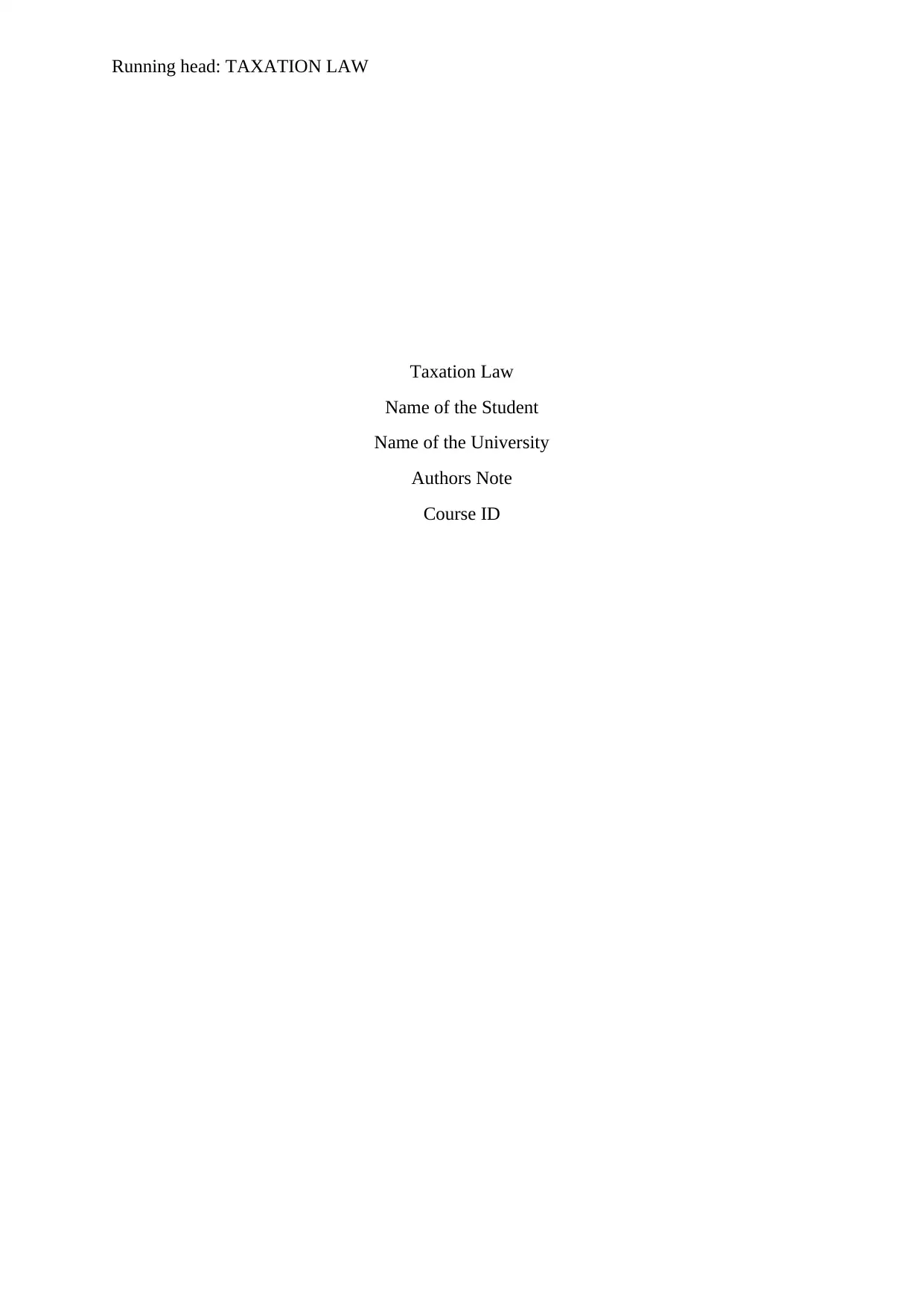
Running head: TAXATION LAW
Taxation Law
Name of the Student
Name of the University
Authors Note
Course ID
Taxation Law
Name of the Student
Name of the University
Authors Note
Course ID
Secure Best Marks with AI Grader
Need help grading? Try our AI Grader for instant feedback on your assignments.
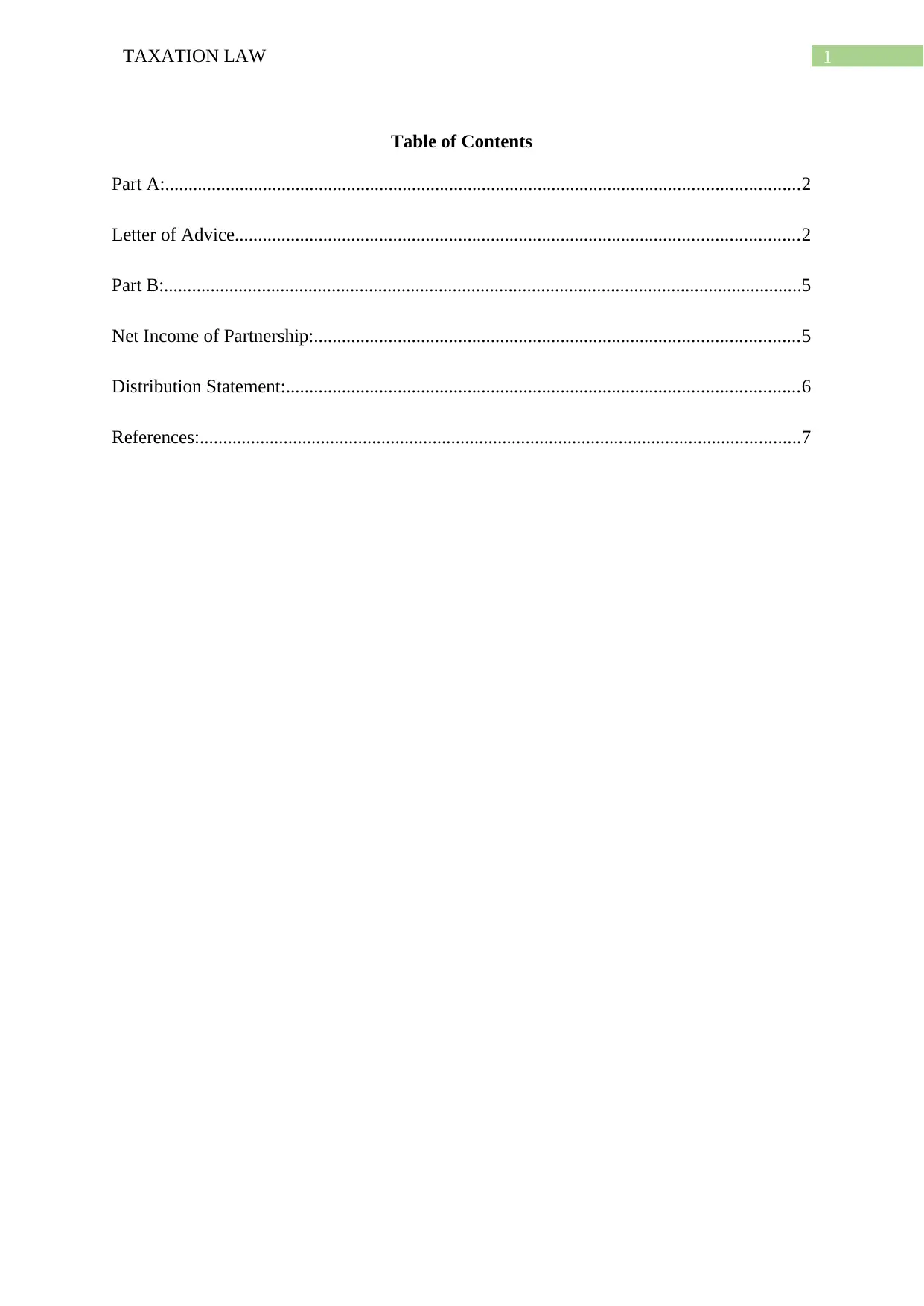
1TAXATION LAW
Table of Contents
Part A:........................................................................................................................................2
Letter of Advice.........................................................................................................................2
Part B:.........................................................................................................................................5
Net Income of Partnership:........................................................................................................5
Distribution Statement:..............................................................................................................6
References:.................................................................................................................................7
Table of Contents
Part A:........................................................................................................................................2
Letter of Advice.........................................................................................................................2
Part B:.........................................................................................................................................5
Net Income of Partnership:........................................................................................................5
Distribution Statement:..............................................................................................................6
References:.................................................................................................................................7
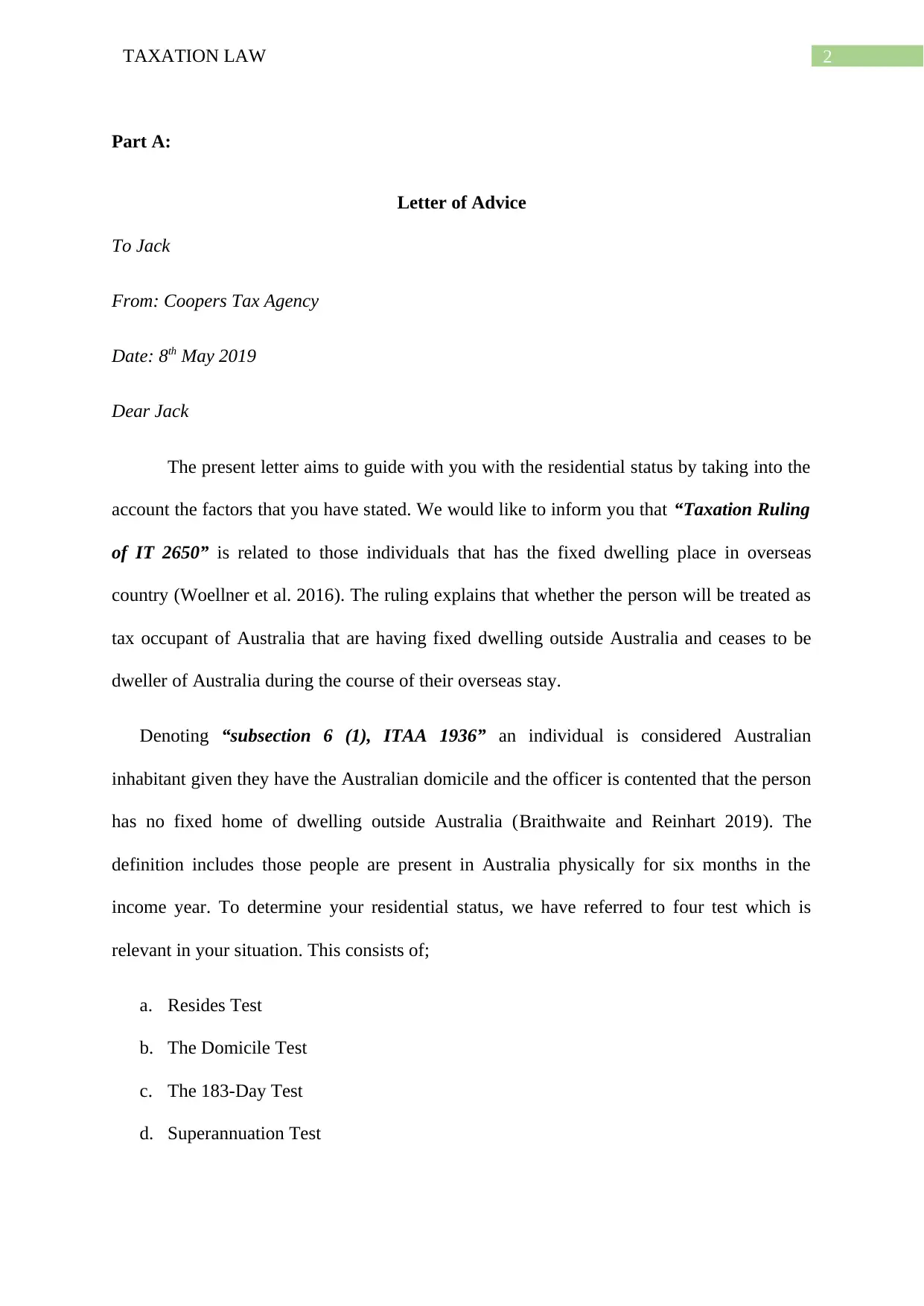
2TAXATION LAW
Part A:
Letter of Advice
To Jack
From: Coopers Tax Agency
Date: 8th May 2019
Dear Jack
The present letter aims to guide with you with the residential status by taking into the
account the factors that you have stated. We would like to inform you that “Taxation Ruling
of IT 2650” is related to those individuals that has the fixed dwelling place in overseas
country (Woellner et al. 2016). The ruling explains that whether the person will be treated as
tax occupant of Australia that are having fixed dwelling outside Australia and ceases to be
dweller of Australia during the course of their overseas stay.
Denoting “subsection 6 (1), ITAA 1936” an individual is considered Australian
inhabitant given they have the Australian domicile and the officer is contented that the person
has no fixed home of dwelling outside Australia (Braithwaite and Reinhart 2019). The
definition includes those people are present in Australia physically for six months in the
income year. To determine your residential status, we have referred to four test which is
relevant in your situation. This consists of;
a. Resides Test
b. The Domicile Test
c. The 183-Day Test
d. Superannuation Test
Part A:
Letter of Advice
To Jack
From: Coopers Tax Agency
Date: 8th May 2019
Dear Jack
The present letter aims to guide with you with the residential status by taking into the
account the factors that you have stated. We would like to inform you that “Taxation Ruling
of IT 2650” is related to those individuals that has the fixed dwelling place in overseas
country (Woellner et al. 2016). The ruling explains that whether the person will be treated as
tax occupant of Australia that are having fixed dwelling outside Australia and ceases to be
dweller of Australia during the course of their overseas stay.
Denoting “subsection 6 (1), ITAA 1936” an individual is considered Australian
inhabitant given they have the Australian domicile and the officer is contented that the person
has no fixed home of dwelling outside Australia (Braithwaite and Reinhart 2019). The
definition includes those people are present in Australia physically for six months in the
income year. To determine your residential status, we have referred to four test which is
relevant in your situation. This consists of;
a. Resides Test
b. The Domicile Test
c. The 183-Day Test
d. Superannuation Test
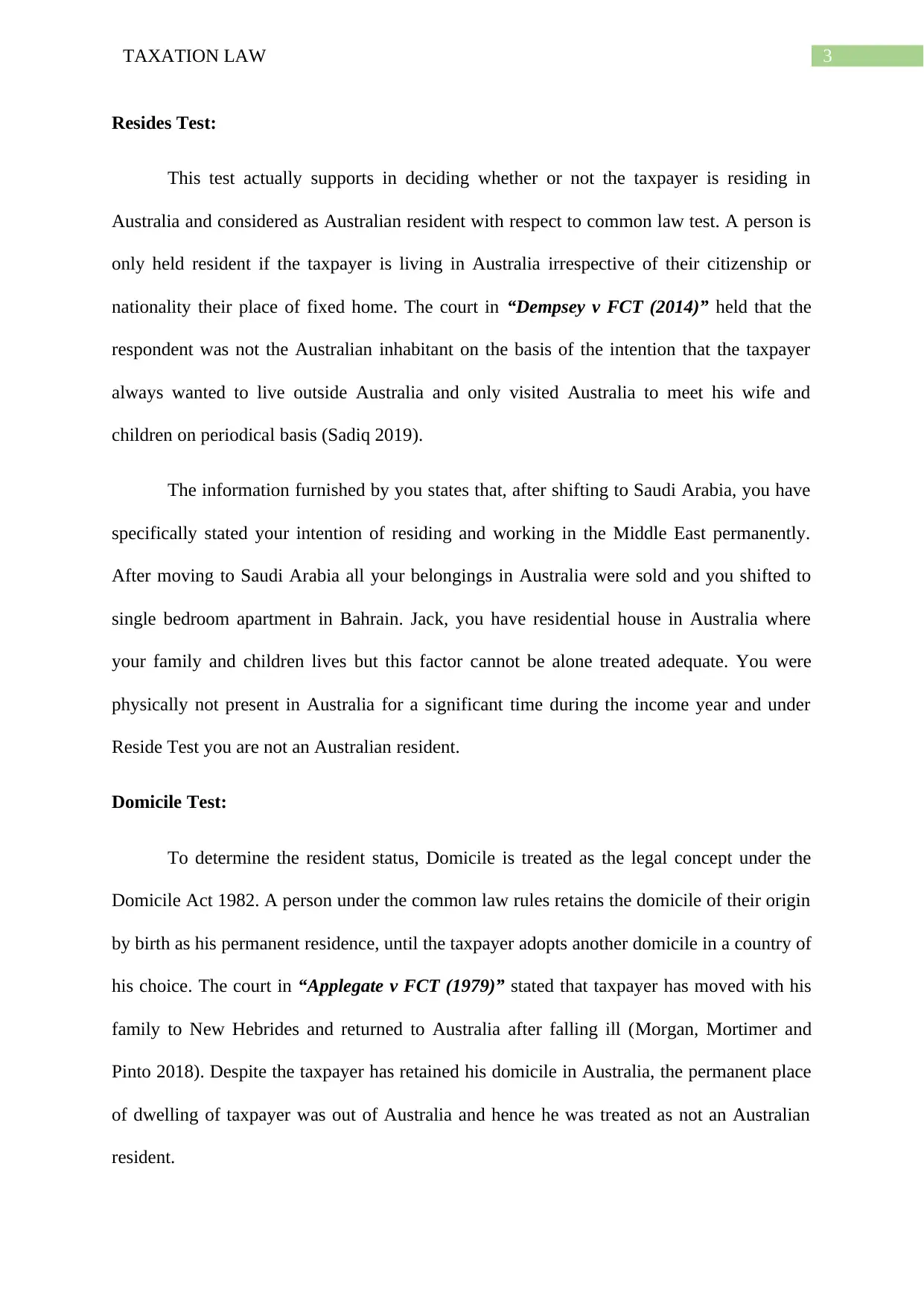
3TAXATION LAW
Resides Test:
This test actually supports in deciding whether or not the taxpayer is residing in
Australia and considered as Australian resident with respect to common law test. A person is
only held resident if the taxpayer is living in Australia irrespective of their citizenship or
nationality their place of fixed home. The court in “Dempsey v FCT (2014)” held that the
respondent was not the Australian inhabitant on the basis of the intention that the taxpayer
always wanted to live outside Australia and only visited Australia to meet his wife and
children on periodical basis (Sadiq 2019).
The information furnished by you states that, after shifting to Saudi Arabia, you have
specifically stated your intention of residing and working in the Middle East permanently.
After moving to Saudi Arabia all your belongings in Australia were sold and you shifted to
single bedroom apartment in Bahrain. Jack, you have residential house in Australia where
your family and children lives but this factor cannot be alone treated adequate. You were
physically not present in Australia for a significant time during the income year and under
Reside Test you are not an Australian resident.
Domicile Test:
To determine the resident status, Domicile is treated as the legal concept under the
Domicile Act 1982. A person under the common law rules retains the domicile of their origin
by birth as his permanent residence, until the taxpayer adopts another domicile in a country of
his choice. The court in “Applegate v FCT (1979)” stated that taxpayer has moved with his
family to New Hebrides and returned to Australia after falling ill (Morgan, Mortimer and
Pinto 2018). Despite the taxpayer has retained his domicile in Australia, the permanent place
of dwelling of taxpayer was out of Australia and hence he was treated as not an Australian
resident.
Resides Test:
This test actually supports in deciding whether or not the taxpayer is residing in
Australia and considered as Australian resident with respect to common law test. A person is
only held resident if the taxpayer is living in Australia irrespective of their citizenship or
nationality their place of fixed home. The court in “Dempsey v FCT (2014)” held that the
respondent was not the Australian inhabitant on the basis of the intention that the taxpayer
always wanted to live outside Australia and only visited Australia to meet his wife and
children on periodical basis (Sadiq 2019).
The information furnished by you states that, after shifting to Saudi Arabia, you have
specifically stated your intention of residing and working in the Middle East permanently.
After moving to Saudi Arabia all your belongings in Australia were sold and you shifted to
single bedroom apartment in Bahrain. Jack, you have residential house in Australia where
your family and children lives but this factor cannot be alone treated adequate. You were
physically not present in Australia for a significant time during the income year and under
Reside Test you are not an Australian resident.
Domicile Test:
To determine the resident status, Domicile is treated as the legal concept under the
Domicile Act 1982. A person under the common law rules retains the domicile of their origin
by birth as his permanent residence, until the taxpayer adopts another domicile in a country of
his choice. The court in “Applegate v FCT (1979)” stated that taxpayer has moved with his
family to New Hebrides and returned to Australia after falling ill (Morgan, Mortimer and
Pinto 2018). Despite the taxpayer has retained his domicile in Australia, the permanent place
of dwelling of taxpayer was out of Australia and hence he was treated as not an Australian
resident.
Secure Best Marks with AI Grader
Need help grading? Try our AI Grader for instant feedback on your assignments.
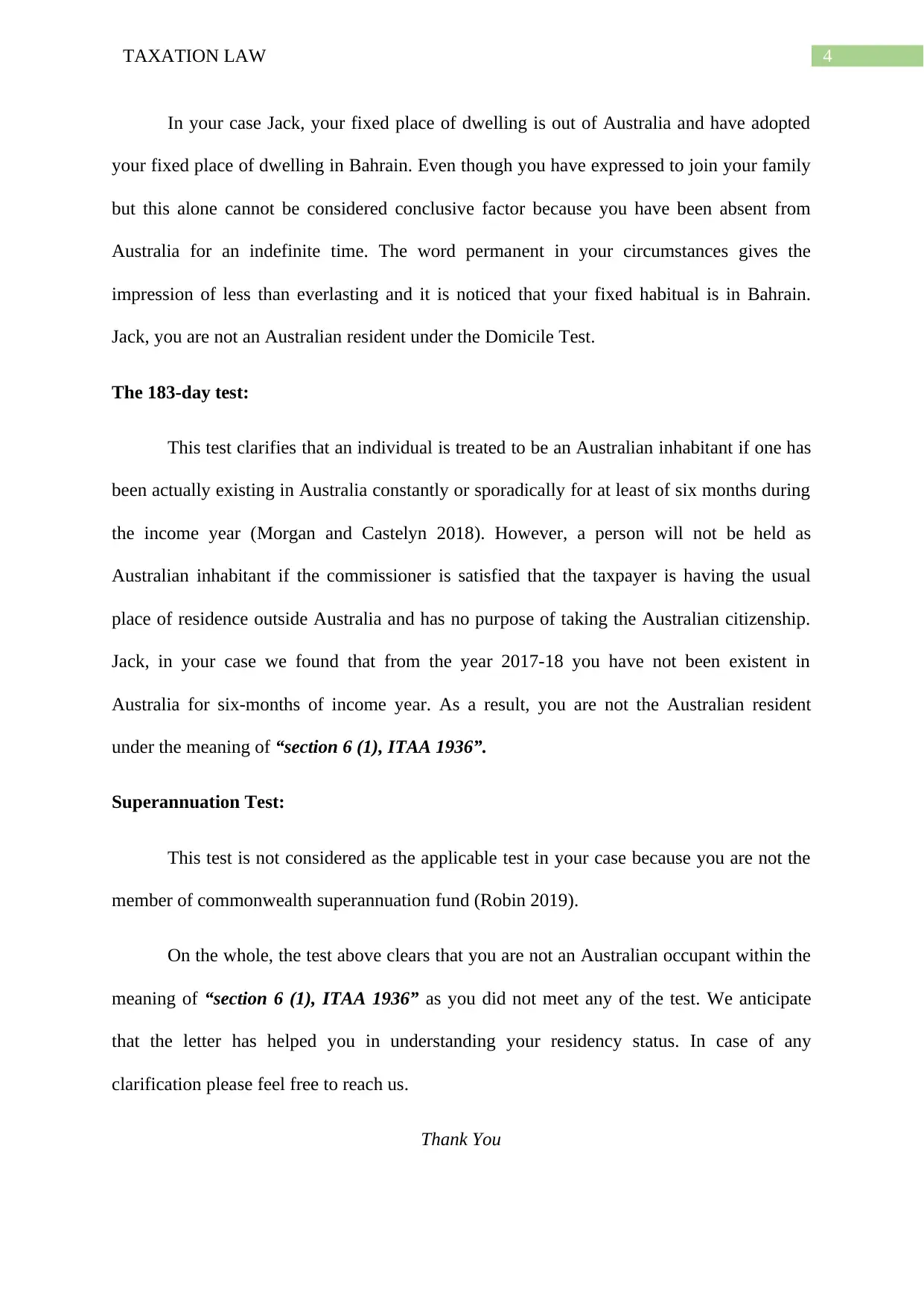
4TAXATION LAW
In your case Jack, your fixed place of dwelling is out of Australia and have adopted
your fixed place of dwelling in Bahrain. Even though you have expressed to join your family
but this alone cannot be considered conclusive factor because you have been absent from
Australia for an indefinite time. The word permanent in your circumstances gives the
impression of less than everlasting and it is noticed that your fixed habitual is in Bahrain.
Jack, you are not an Australian resident under the Domicile Test.
The 183-day test:
This test clarifies that an individual is treated to be an Australian inhabitant if one has
been actually existing in Australia constantly or sporadically for at least of six months during
the income year (Morgan and Castelyn 2018). However, a person will not be held as
Australian inhabitant if the commissioner is satisfied that the taxpayer is having the usual
place of residence outside Australia and has no purpose of taking the Australian citizenship.
Jack, in your case we found that from the year 2017-18 you have not been existent in
Australia for six-months of income year. As a result, you are not the Australian resident
under the meaning of “section 6 (1), ITAA 1936”.
Superannuation Test:
This test is not considered as the applicable test in your case because you are not the
member of commonwealth superannuation fund (Robin 2019).
On the whole, the test above clears that you are not an Australian occupant within the
meaning of “section 6 (1), ITAA 1936” as you did not meet any of the test. We anticipate
that the letter has helped you in understanding your residency status. In case of any
clarification please feel free to reach us.
Thank You
In your case Jack, your fixed place of dwelling is out of Australia and have adopted
your fixed place of dwelling in Bahrain. Even though you have expressed to join your family
but this alone cannot be considered conclusive factor because you have been absent from
Australia for an indefinite time. The word permanent in your circumstances gives the
impression of less than everlasting and it is noticed that your fixed habitual is in Bahrain.
Jack, you are not an Australian resident under the Domicile Test.
The 183-day test:
This test clarifies that an individual is treated to be an Australian inhabitant if one has
been actually existing in Australia constantly or sporadically for at least of six months during
the income year (Morgan and Castelyn 2018). However, a person will not be held as
Australian inhabitant if the commissioner is satisfied that the taxpayer is having the usual
place of residence outside Australia and has no purpose of taking the Australian citizenship.
Jack, in your case we found that from the year 2017-18 you have not been existent in
Australia for six-months of income year. As a result, you are not the Australian resident
under the meaning of “section 6 (1), ITAA 1936”.
Superannuation Test:
This test is not considered as the applicable test in your case because you are not the
member of commonwealth superannuation fund (Robin 2019).
On the whole, the test above clears that you are not an Australian occupant within the
meaning of “section 6 (1), ITAA 1936” as you did not meet any of the test. We anticipate
that the letter has helped you in understanding your residency status. In case of any
clarification please feel free to reach us.
Thank You
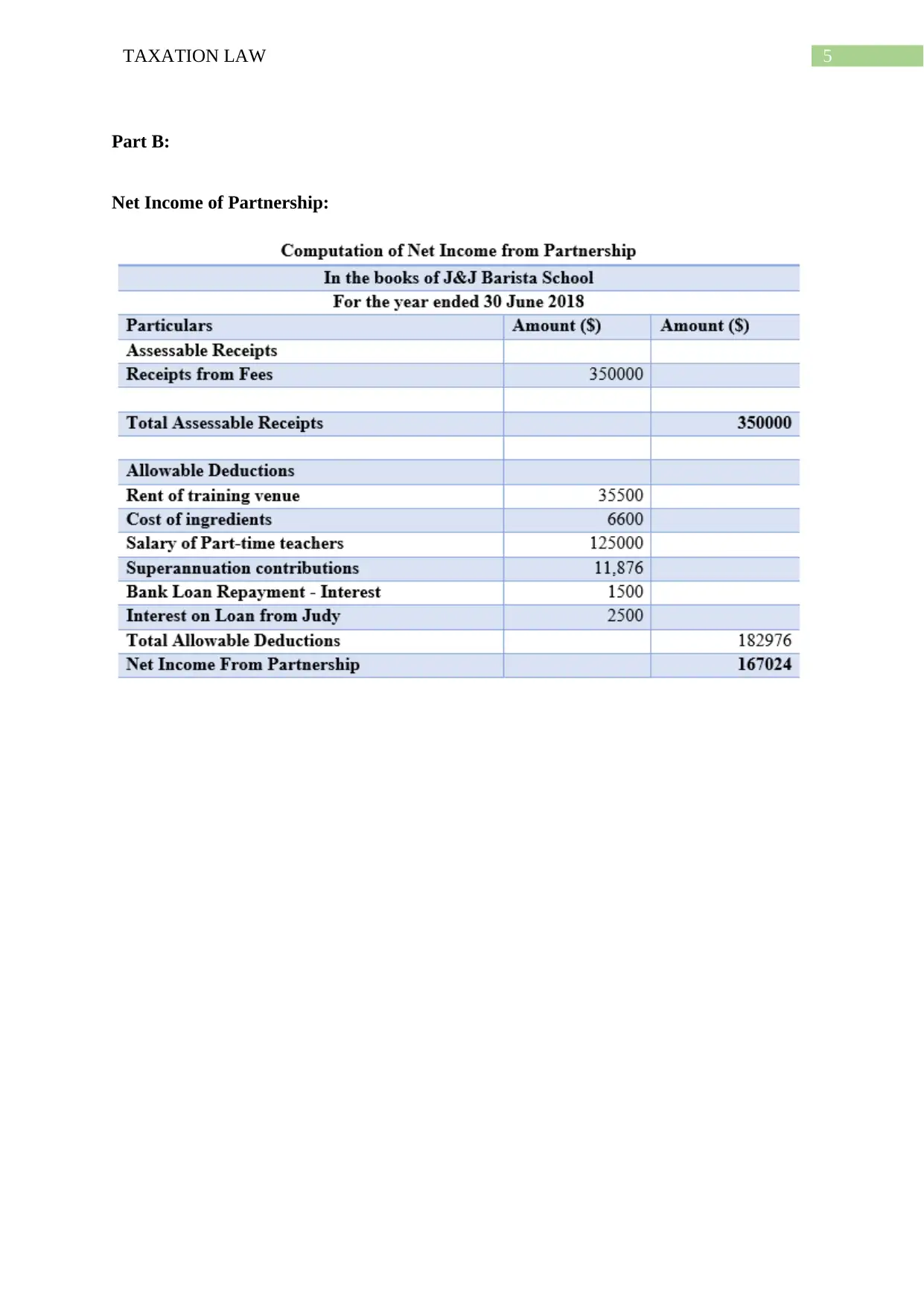
5TAXATION LAW
Part B:
Net Income of Partnership:
Part B:
Net Income of Partnership:
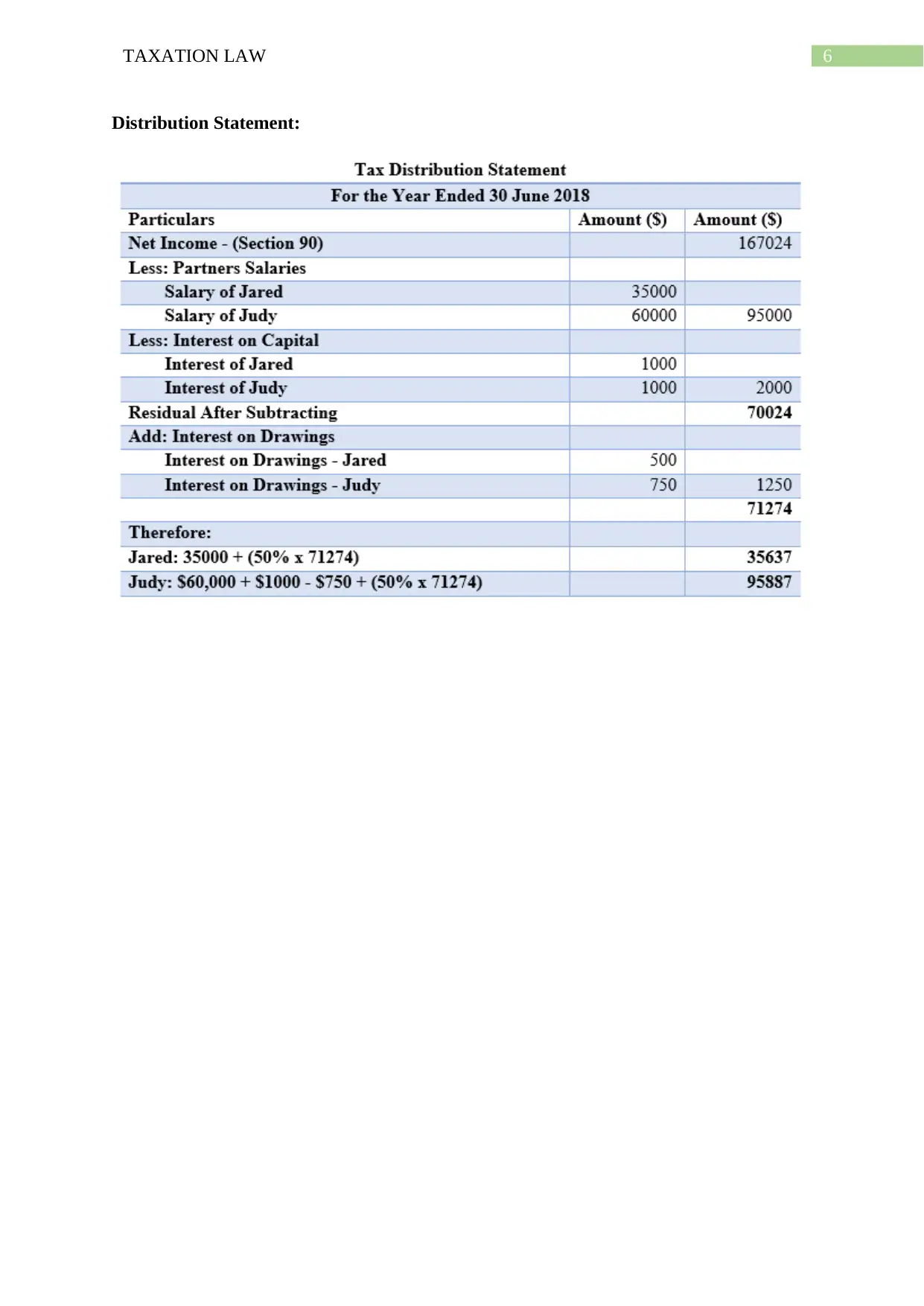
6TAXATION LAW
Distribution Statement:
Distribution Statement:
Paraphrase This Document
Need a fresh take? Get an instant paraphrase of this document with our AI Paraphraser
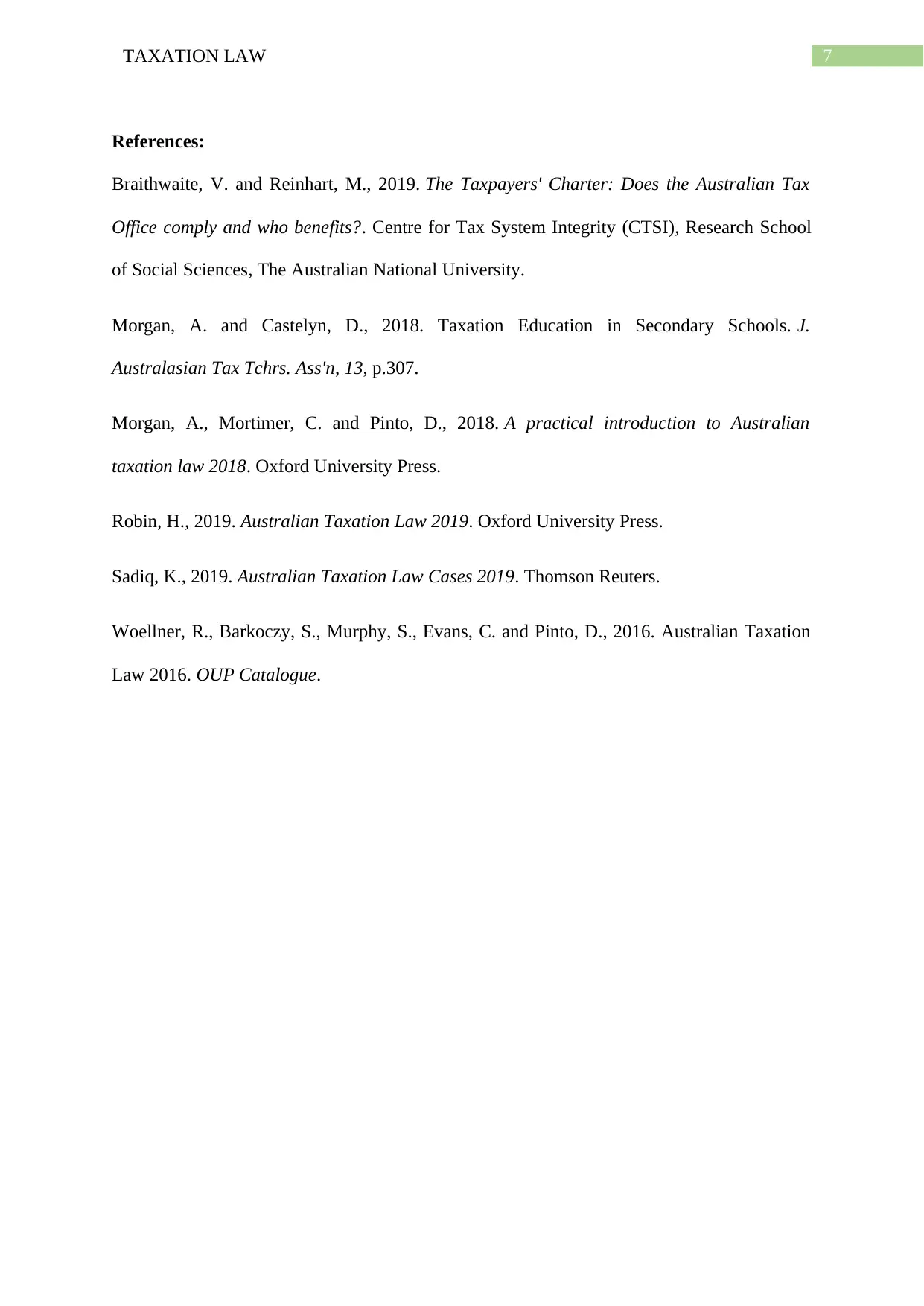
7TAXATION LAW
References:
Braithwaite, V. and Reinhart, M., 2019. The Taxpayers' Charter: Does the Australian Tax
Office comply and who benefits?. Centre for Tax System Integrity (CTSI), Research School
of Social Sciences, The Australian National University.
Morgan, A. and Castelyn, D., 2018. Taxation Education in Secondary Schools. J.
Australasian Tax Tchrs. Ass'n, 13, p.307.
Morgan, A., Mortimer, C. and Pinto, D., 2018. A practical introduction to Australian
taxation law 2018. Oxford University Press.
Robin, H., 2019. Australian Taxation Law 2019. Oxford University Press.
Sadiq, K., 2019. Australian Taxation Law Cases 2019. Thomson Reuters.
Woellner, R., Barkoczy, S., Murphy, S., Evans, C. and Pinto, D., 2016. Australian Taxation
Law 2016. OUP Catalogue.
References:
Braithwaite, V. and Reinhart, M., 2019. The Taxpayers' Charter: Does the Australian Tax
Office comply and who benefits?. Centre for Tax System Integrity (CTSI), Research School
of Social Sciences, The Australian National University.
Morgan, A. and Castelyn, D., 2018. Taxation Education in Secondary Schools. J.
Australasian Tax Tchrs. Ass'n, 13, p.307.
Morgan, A., Mortimer, C. and Pinto, D., 2018. A practical introduction to Australian
taxation law 2018. Oxford University Press.
Robin, H., 2019. Australian Taxation Law 2019. Oxford University Press.
Sadiq, K., 2019. Australian Taxation Law Cases 2019. Thomson Reuters.
Woellner, R., Barkoczy, S., Murphy, S., Evans, C. and Pinto, D., 2016. Australian Taxation
Law 2016. OUP Catalogue.
1 out of 8
Your All-in-One AI-Powered Toolkit for Academic Success.
+13062052269
info@desklib.com
Available 24*7 on WhatsApp / Email
![[object Object]](/_next/static/media/star-bottom.7253800d.svg)
Unlock your academic potential
© 2024 | Zucol Services PVT LTD | All rights reserved.




